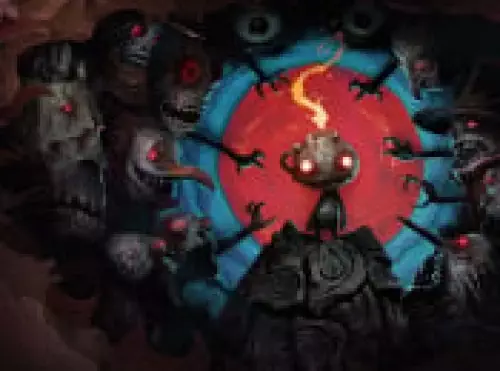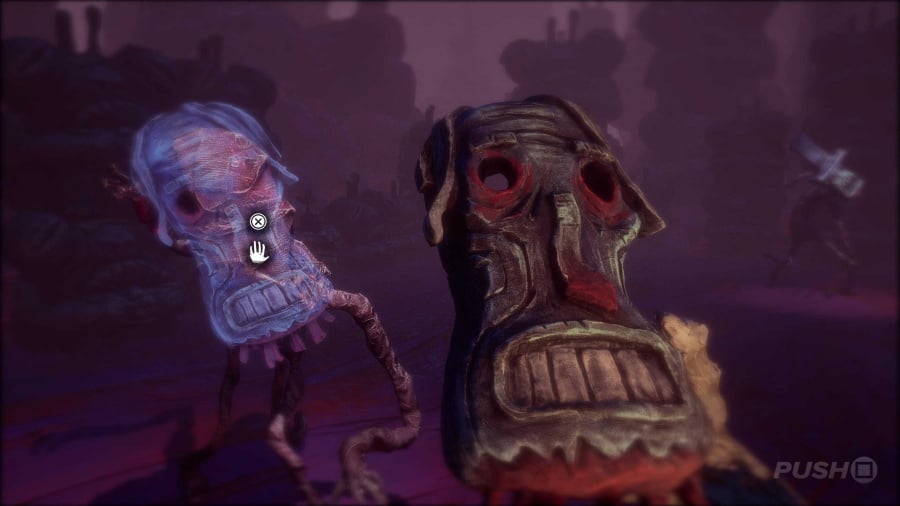- Home
- Playstation
- Review: The Midnight Walk (PSVR2)

Review: The Midnight Walk (PSVR2)

The Midnight Walk is an experience imbued with beauty and poignancy. It delivers a narrative steeped in despair, heartache, and grief, encapsulated within an immaculate claymation visual veneer. However, it demands patience for its brilliance to unfold — something we found challenging at times to sustain.
The narrative of The Midnight Walk follows the journey of The Burned One (controlled by the player) and Pot Boy, as they adventure towards Moon Mountain tasked with spreading the fire to resurrect the sun. Throughout their quest, they stumble upon “stories”, uncovering everything from villages of severed heads to a craftsman pressuring his daughter to lead when she yearns only to dance.
Right from the initial gameplay, we were captivated by its unique visual aesthetics. The incorporation of claymation is magnificently executed, with every single screenshot seemingly drawn straight from films like A Nightmare Before Christmas or The Corpse’s Bride. Distorted buildings, gnarled mountain ranges, and decayed beings speaking in rough, scraping voices — it was all brilliantly crafted.

The creature designs are unforgettable. The Grinners, with their hauntingly large smiles and unsettlingly staring eyes, are particularly impressive. The animation technique further heightens the effectiveness of the clay design, capturing jittery movements and crunching sounds that vitalize the inhabitants of The Midnight Walk.
However, while visually enthralling, the game struggles to fully engage the player in the initial hour or so. Gameplay mechanics are quite basic, with primary stealth sections and minimal player involvement beyond ordering Pot Boy to ignite candles. In our case, these opening hours felt devoid of a compelling hook.
Fortunately, we experienced a shift in perspective after our first story, where we uncovered a violent past between the heads of Nobodyville and a being named the Molgrim. Despite its horrifying and eerie design elements, The Midnight Walk’s storytelling mode — marked by a raspy narrative voice and slow-moving visuals underscored by a mournful soundtrack — unfolded something truly beautiful.

From that point on, The Midnight Walk truly resonated with us, distracting us from the simplistic game mechanics and level designs. Each subsequent level introduced a new setting for us to traverse through a hauntingly beautiful landscape, encounter a narrative centered around sorrow, and allow us to be swept away by the score. The soundtrack is undoubtedly on par with Clair Obscur: Expedition 33, boasting one of the finest scores you’ll hear this year.
Although The Midnight Walk can indeed be played on a conventional screen, its true enchantment is best expressed in VR. Crafted with PSVR2 in mind, the game pushes the boundaries of visual immersion. Usual VR limitations aside, the game’s blink mechanic is perhaps its most impressive feature.
The blink mechanic enhances the mystique by allowing the player to listen for hidden objects or activate sapphire orbs to unlock passageways; achieved by either pressing a button or physically closing your eyes with the Sony headset. This results in spine-chilling moments evoked by the screeching sounds of loathsome creatures advancing near you or the abrupt changes in the gaming environment.

The mix of this mechanism with darker levels, which forces you to hold a matchstick for illumination, adds nerve-wracking tension amid the emotional upheaval of the world within. It’s not as absorbing as some of the goosebumps-inducing moments in other VR titles such as Metro Awakening, but it still left a strong impression on us.
Regrettably, the VR version suffers from certain technical shortcomings. The graphics can present rough edges, especially on character models. This is particularly noticeable during cutscenes which deviate from the first-person view. Mostly, this does not pose a significant issue, and the game’s levels and vistas never failed to leave us in awe with their twisted elegance.
However, there were also instances — largely during the beginning hours of gameplay — that resulted in frustrating glitches which necessitated a complete restart. At times lit matches would freeze mid-air, particularly when using the cannon. We eventually discerned that the cannon caused the matches to vibrate before disappearing, but it was a clumsy and confusing process, lacking clear directions.

Moreover, in sections where Pot Boy was required to light candles, the action prompt would sometimes fail to appear. We were compelled to switch to a flat screen to overcome this problem once. Thankfully, this issue ceased to occur after the initial hour or so of gameplay.
For those seeking a more streamlined experience, the conventional screen mode is available. We believe, however, that while the flat screen mode effectively delivers the game’s emotional essence, it falls short of the VR version’s intensity. The game’s creatures lack the same threatening presence they have in VR, and the vistas don’t inspire the same wonder. Given that the graphics are so integral to the identity of The Midnight Walk, the flatscreen version doesn’t manage to evoke the same emotions as the VR counterpart.
Conclusion
By the time we concluded The Midnight Walk, all prior technical grievances had ceased to matter. What remained was the unforgettable impression of a haunting universe filled with contemplative narratives, striking visuals, and a resonating soundtrack.
Those hoping for a gripping survival horror gaming adventure might feel disappointed. Initially, we shared a similar expectation, especially considering the VR platform. But what we received was something equally if not more valuable — a game filled with unforgettable emotional moments, poignant narrative, and rich melancholic undertones. No doubt, The Midnight Walk is an experience that will persevere long within our memories.
